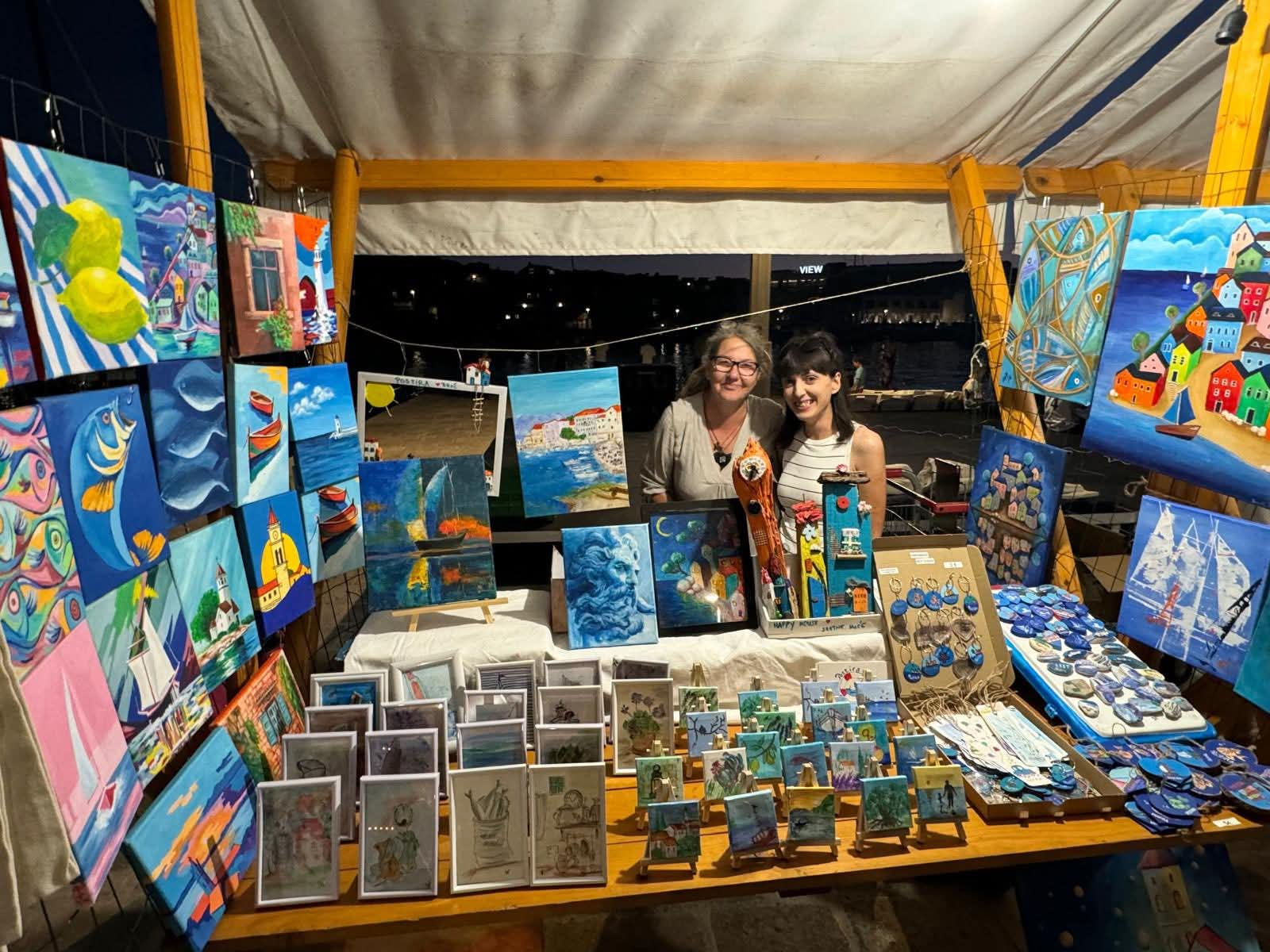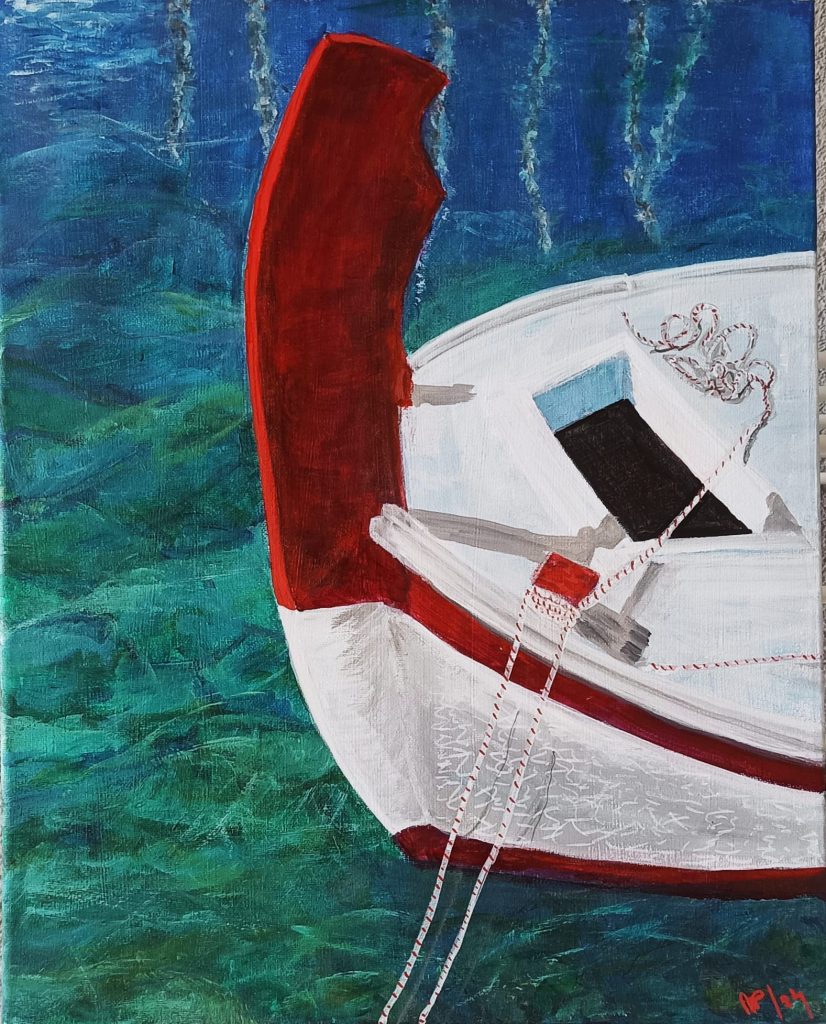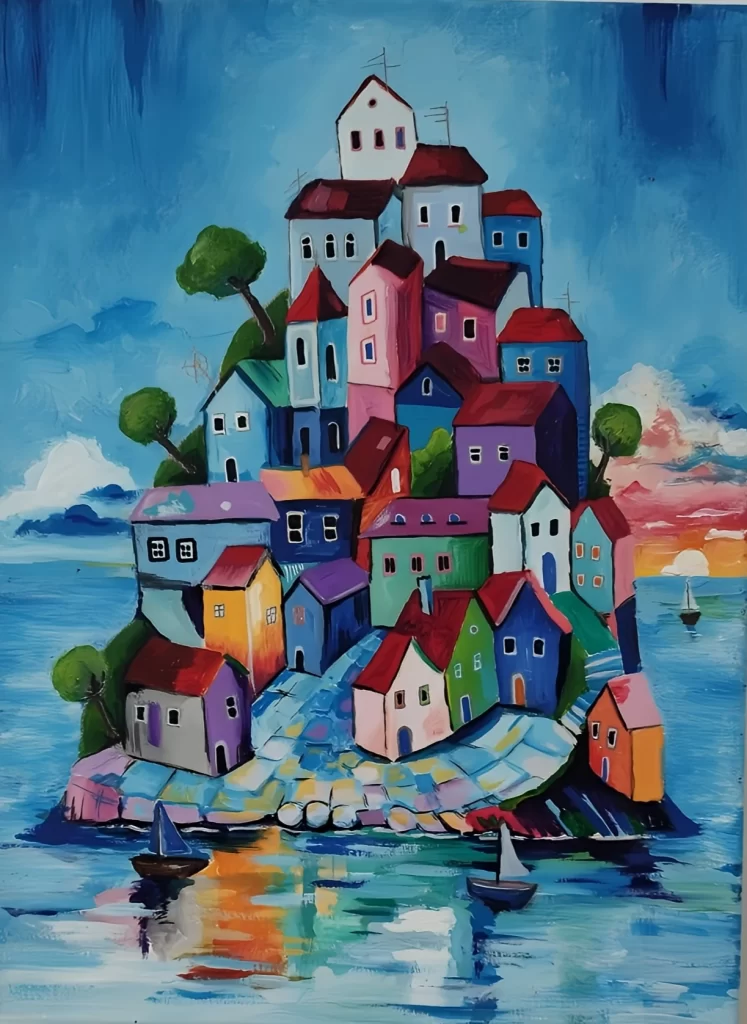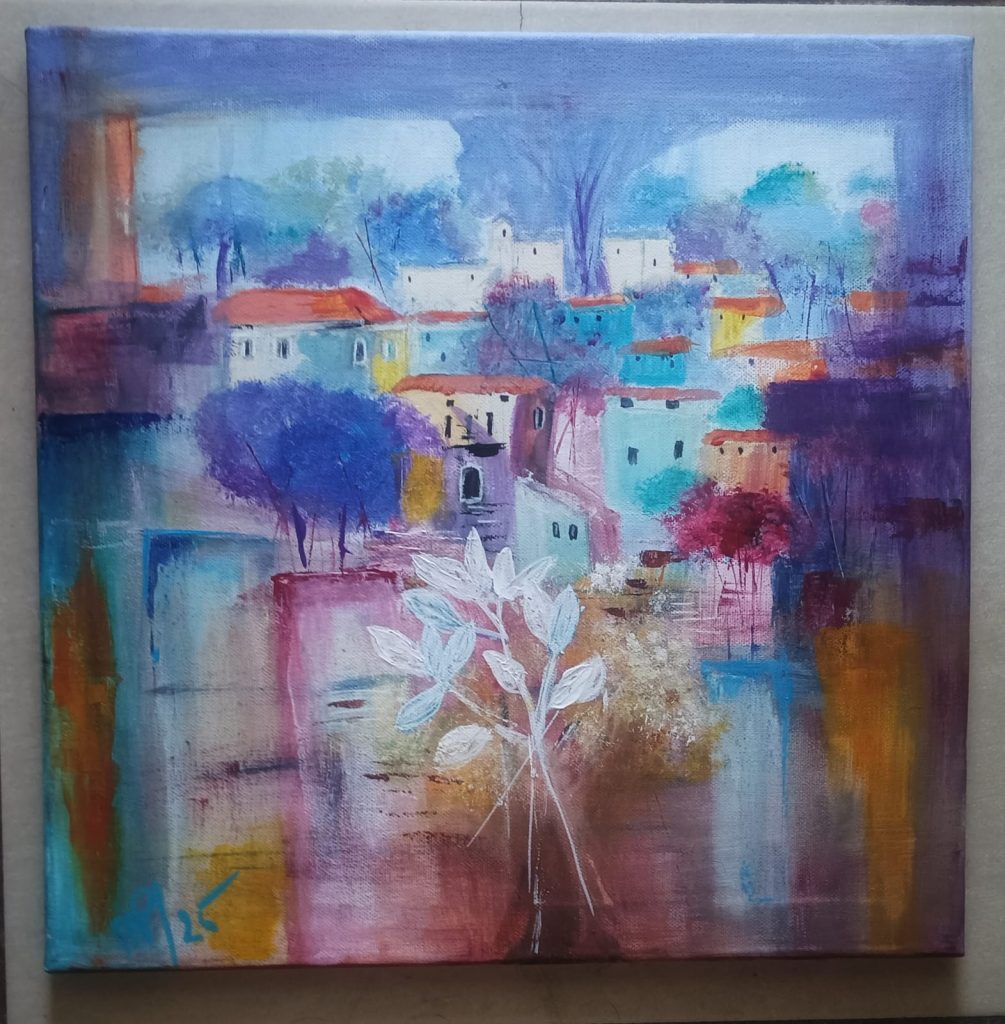
Josipa & Mariana Plazibat (Photo: Josipa Plazibat)
Some links in this article may lead to products or services for sale.
The hot summer days are reaching their peak in this part of the world, so The History Avenue went on a little adventure to the Island of Brač, or more precisely, Postira to explore that timeless connection between history, art, and tradition. There is something alluring and intriguing in these three things that, when perfectly blended, create a beauty that people only with refined taste can understand. And what better way to explore this, than to talk with two guardians of that tradition who tell their story through their art they present to tourists (and locals) in the town fairs. They are Mariana and Josipa Plazibat, two artists, and mother and daughter-in-law to whom we talked about local traditions, history, and life on the island.
The Deep Connection Between the Island and the Sea
At the beginning of our conversation, both Mariana and Josipa emphasize their fascination with the strong bond between the island and the sea.
THA: What Dalmatian tradition inspires you most when you create? Is there a particular part of Dalmatian culture that especially attracts you and often appears in your work?
Mariana: Always the relationship between the island and the sea. Islands are like continents, with their own rules, a bit surreal. I’d even dare to say self-grown, like the plants and people who inhabit them. And the sea… that’s precisely the barrier that separates it from the mainland, that occasionally traps and isolates it, so it can remember its own roots.

Josipa likes to explore the intimacy of life, deeply marked by the traditions.
Josipa: What fascinates me most about Dalmatian tradition is the deep connection with the sea that permeates every aspect of life. The sea isn’t just a geographical given—it’s the pulse that dictates the rhythm of life. In my work, I constantly return to the intimacy of life in small island towns, where generations pass on the same stories, the same routes, the same habits. This way of living with the sea—the way we adapt to the waves, the wind, the seasons—that’s something I try to capture on canvas. It’s not a romanticized image of the Mediterranean, but the real, everyday life where the sea determines the day’s rhythm.
Art and Tradition: Can They Function Together?
Interesting is their opinion on art and tradition. Both agree it’s natural they function together.
THA: How do you see the relationship between art and tradition? Can they successfully function together?
Mariana: One wouldn’t make sense without the other. Regardless of the type of art, it’s tied to tradition. If one changes, it causes a change in the other.

Josipa: I absolutely believe that art and tradition not only can, but should work together. In our region, it’s not just possible—it’s natural and desirable! Tradition provides deep roots from which art can grow, and at the same time, it gives it an authenticity that people recognize and appreciate. I notice that people often look for works that evoke something familiar, something they connect with their own experience or memories. When someone sees stone houses, an olive grove, or a bura wind over the sea in a painting, it stirs emotions deeply rooted in our collective memory. On the other hand, tourists want to take an authentic piece of the Mediterranean spirit with them—not kitsch, but something that truly reflects the soul of this region. My approach is to use tradition as a foundation, but through contemporary artistic language. In this way, I create bridges between the past and the present, between the local and the universal.
Although art has a special value, today, mass-produced souvenirs are popular. Many tourists bring them home for memory. But, there is something in the hand-made pieces…
THA: Today, mass-produced souvenirs are popular, but handmade ones have special value. What do you think makes these handmade souvenirs special, for example, paintings of Dalmatian coves, narrow streets (kalete), and stone houses?
Mariana says there’s an energy in handcrafted pieces…
Mariana: Mass production lacks soul. A handcrafted piece of wood, canvas, or a stone requires, first and foremost, time, energy, and an original idea. All of this makes each piece unique, which, frankly, cannot be said for mass production.
Josipa accentuates the uniqueness and the story behind every handmade piece.
Josipa: I completely agree with that approach! When I travel, I always look for something handmade because I know I’m carrying a unique story with me. Mass-produced souvenirs have their role, but for a relatively small price difference, you can get a true unique piece with a soul. What makes hand-painted pictures of Dalmatian coves, narrow streets (kalete), and stone houses special is precisely that uniqueness—every brushstroke, every shade of color carries the artist’s experience of that place at a specific moment.
Dalmatian Motifs: A Legacy
Dalmatian motifs in art and souvenirs are more than just beautiful decorations. They are a legacy. As Josipa says, they are a documentation of time. Mariana agrees this legacy can be a serious artistic expression.
THA: Can today’s paintings of Dalmatian motifs be more than just beautiful decorations? Can they be a serious artistic expression?
Mariana: Of course.
Josipa: Dalmatian motifs are far more than mere decorative elements—they represent a rich spectrum of themes and concepts that can carry deep artistic content. This subject matter provides incredibly broad opportunities for serious artistic expression. On one hand, we have depictions of a unique Dalmatian way of life that is disappearing—traditional crafts, old fish markets, decaying stone houses, generations leaving. This becomes a kind of documentation of time, an anthropological study through painting. On the other hand, there’s the role of preserving cultural heritage—when I paint an old kaleta, I’m not just creating a work of art but also archiving a part of our civilization. Dalmatian landscapes can also serve as a metaphor for universal themes—the transience of time, the relationship between man and nature, resistance to globalization. Stone walls can speak of endurance, coves of the hidden depths of the human soul. The key is how the artist approaches the theme—superficially or with the intention of speaking about the universal through the local.

For both, feelings and atmosphere are essential parts of every brushstroke.
THA: What role do feelings and atmosphere play in your artistic expression?
Josipa: Feelings and atmosphere are the heart of my painting—perhaps the most important element. Technique is just a tool; what makes a painting alive is the ability to convey the emotion of the moment. Whether I’m painting a summer day on the beach or deserted kalete during a bura wind in March, it’s essential for me to capture that specific energy of the place and time.
Mariana: Without pouring their heart and feelings into even the smallest brushstroke, I believe an artist’s work would lose much of its value. It would feel as if something vital had been taken away from both the island and the sea.
Being Without History is Like Being Without Identity
As Dalmatia isn’t just sea and sun, but also people, we were interested if history was still alive in small everyday traditions. While Josipa agrees, Mariana underlines the importance of the roots in traditions.
THA: Dalmatia is not just sea and sun, but also people, customs, feelings… Do you think the way of life in Dalmatia has changed? Is history still alive in small everyday traditions?
Josipa: Yes, and that’s natural, and we are here to seize the moment and enjoy it!
Mariana: The way of life always changes with time, and that’s necessary. But it’s equally necessary to have roots in tradition itself. Small places still preserve it, despite the changes. Being without history is like being without an identity.
There are traditions still alive on the island, but fast-paced life also affects this world.
THA: Are there any old Dalmatian customs or traditions that are particularly dear to you? Do you practice them?
Josipa: I’m not particularly active in practicing old customs, but there is one tradition that is extremely dear to me—traditional cuisine and pastries. That is perhaps the only Dalmatian tradition I truly live and practice!
Mariana: Most old traditional customs on the island are related to religious life. Some of them haven’t changed since I can remember. However, the fast-paced way of life hasn’t spared the island either.

Dalmatian Vibes?
When talking about Dalmatian aesthetics or vibe, we needed to ask Mariana and Josipa what they think makes the aesthetics. Their answer gave us the interesting and unique contrast between strength and flexibility you can only find in this part of the world.
THA: Finally, what three things do you think best describe the Dalmatian aesthetic or ‘vibe’? Why those three?
Josipa: For me, the three things that best describe Dalmatian aesthetics are the sea, boats, and stone houses—and each of them has its own symbolism.
The sea is the foundation of everything—it dictates the rhythm of life, the colors of the landscape, the way of thinking. Dalmatian aesthetics simply do not exist without the sea. The sea is color and light and sound all in one.
Boats represent the connection between man and the sea, a practicality that has become poetry. Every boat tells a story of how Dalmatians adapt to the sea, use it, respect it. Boats are a moving sculpture on that great blue stage.
Stone houses are permanent in contrast to the changeability of the sea. They speak of generations that lived there, of how man tamed stone and created shelter. That contrast of white stone and the blue sea—that is the visual essence of Dalmatia. These houses have endured everything—buras, wars, time—and still stand as monuments of simplicity and functionality.
Mariana: The stone from which the island itself is made, old stone houses from whose crevices capers grow.
The dialect that differs from place to place, which should be nurtured and not feared that everyone will understand us. The language of the heart is universal.
And of course, the sea. Because Dalmatia without the sea is not Dalmatia. By that, I don’t mean beautifully arranged beaches, although I love them, but that whimsical winter sea, summer storms (neverin), heavy southerly winds (jugo) that test the limits of endurance and faith in island life.
Josipa | Mariana | Postira Vibes Art&Souvenirs
The people featured in this article are included based on editorial relevance, and no payment or sponsorship was involved in their placement.
